Business Environment Analysis: Types, Structures, and Interrelations
VerifiedAdded on 2023/01/06
|13
|4029
|63
Report
AI Summary
This report provides a comprehensive analysis of the business environment, focusing on organizational structures, types, and purposes. It explores private, public, and voluntary organizations, examining their size and scope with examples like Tesco and Shell. The report delves into organizational structures and their interrelation with different departments such as sales and marketing, human resources and IT, and finance. It further implements internal and external analysis of specific organizations to identify strengths and weaknesses, explaining how these relate to external macro factors. The report also includes a detailed analysis of the interrelation between strengths and weaknesses with external macro elements, offering insights into how businesses operate within their environment.
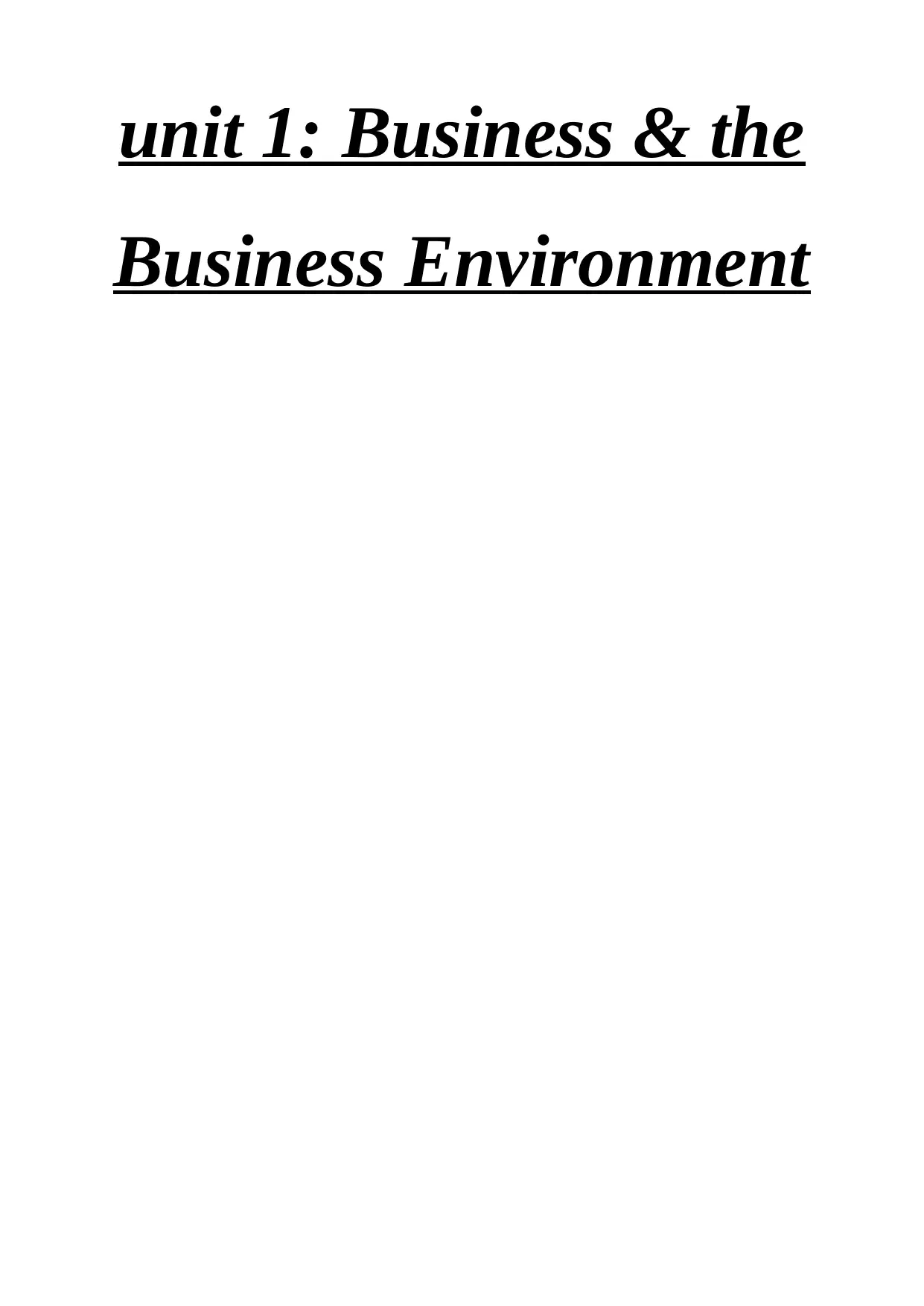
unit 1: Business & the
Business Environment
Business Environment
Paraphrase This Document
Need a fresh take? Get an instant paraphrase of this document with our AI Paraphraser
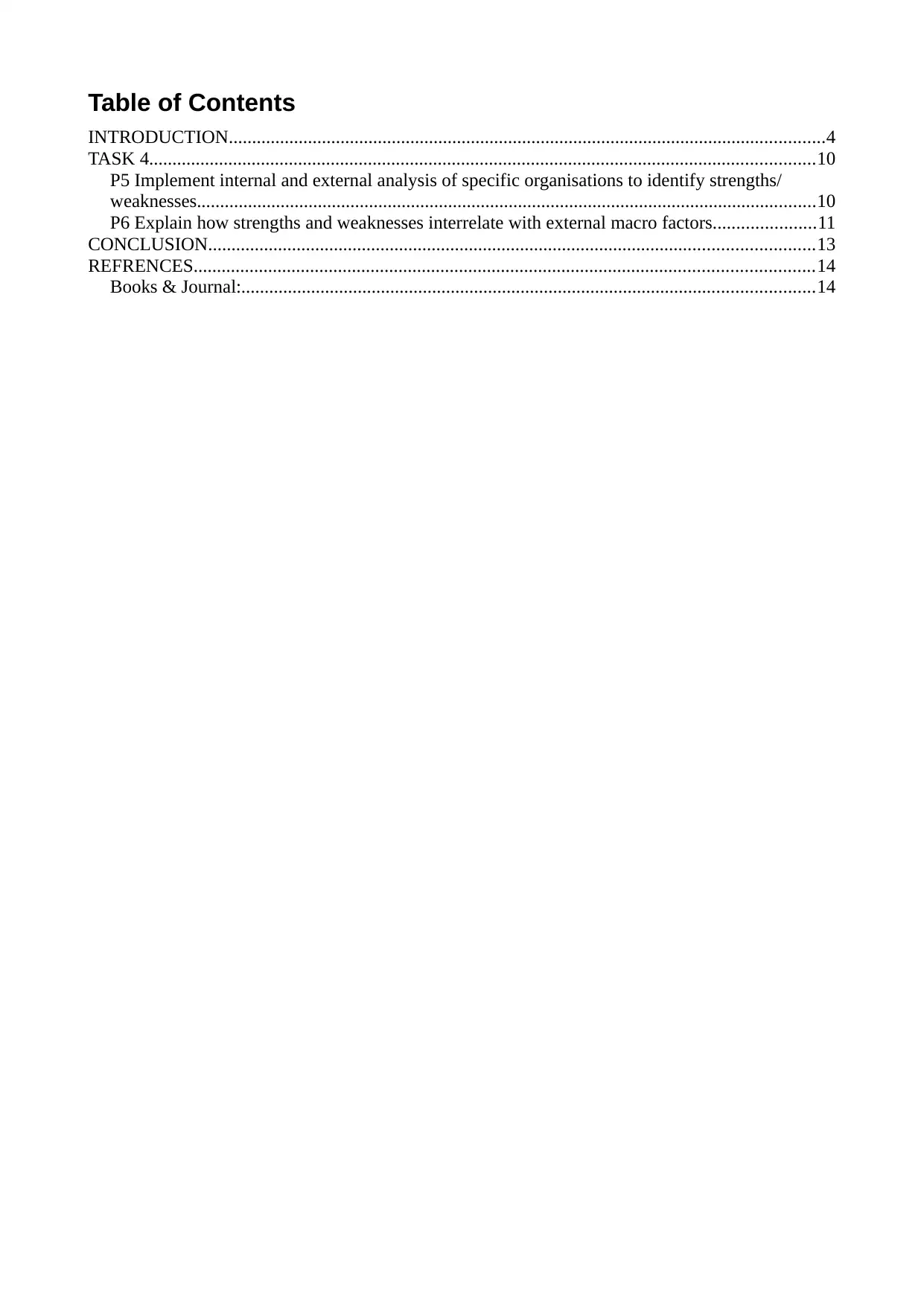
Table of Contents
INTRODUCTION................................................................................................................................4
TASK 4...............................................................................................................................................10
P5 Implement internal and external analysis of specific organisations to identify strengths/
weaknesses.....................................................................................................................................10
P6 Explain how strengths and weaknesses interrelate with external macro factors......................11
CONCLUSION..................................................................................................................................13
REFRENCES.....................................................................................................................................14
Books & Journal:...........................................................................................................................14
INTRODUCTION................................................................................................................................4
TASK 4...............................................................................................................................................10
P5 Implement internal and external analysis of specific organisations to identify strengths/
weaknesses.....................................................................................................................................10
P6 Explain how strengths and weaknesses interrelate with external macro factors......................11
CONCLUSION..................................................................................................................................13
REFRENCES.....................................................................................................................................14
Books & Journal:...........................................................................................................................14
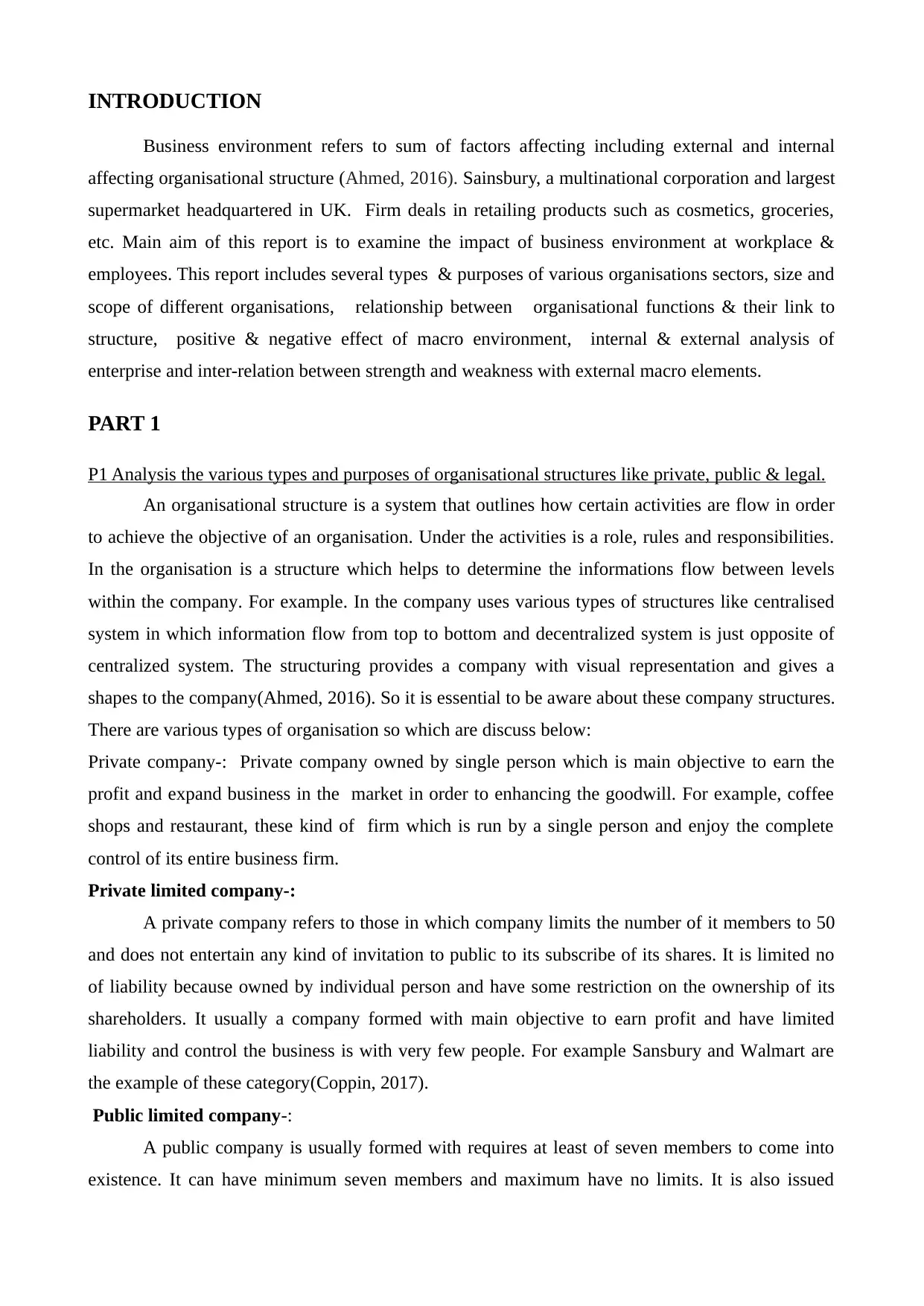
INTRODUCTION
Business environment refers to sum of factors affecting including external and internal
affecting organisational structure (Ahmed, 2016). Sainsbury, a multinational corporation and largest
supermarket headquartered in UK. Firm deals in retailing products such as cosmetics, groceries,
etc. Main aim of this report is to examine the impact of business environment at workplace &
employees. This report includes several types & purposes of various organisations sectors, size and
scope of different organisations, relationship between organisational functions & their link to
structure, positive & negative effect of macro environment, internal & external analysis of
enterprise and inter-relation between strength and weakness with external macro elements.
PART 1
P1 Analysis the various types and purposes of organisational structures like private, public & legal.
An organisational structure is a system that outlines how certain activities are flow in order
to achieve the objective of an organisation. Under the activities is a role, rules and responsibilities.
In the organisation is a structure which helps to determine the informations flow between levels
within the company. For example. In the company uses various types of structures like centralised
system in which information flow from top to bottom and decentralized system is just opposite of
centralized system. The structuring provides a company with visual representation and gives a
shapes to the company(Ahmed, 2016). So it is essential to be aware about these company structures.
There are various types of organisation so which are discuss below:
Private company-: Private company owned by single person which is main objective to earn the
profit and expand business in the market in order to enhancing the goodwill. For example, coffee
shops and restaurant, these kind of firm which is run by a single person and enjoy the complete
control of its entire business firm.
Private limited company-:
A private company refers to those in which company limits the number of it members to 50
and does not entertain any kind of invitation to public to its subscribe of its shares. It is limited no
of liability because owned by individual person and have some restriction on the ownership of its
shareholders. It usually a company formed with main objective to earn profit and have limited
liability and control the business is with very few people. For example Sansbury and Walmart are
the example of these category(Coppin, 2017).
Public limited company-:
A public company is usually formed with requires at least of seven members to come into
existence. It can have minimum seven members and maximum have no limits. It is also issued
Business environment refers to sum of factors affecting including external and internal
affecting organisational structure (Ahmed, 2016). Sainsbury, a multinational corporation and largest
supermarket headquartered in UK. Firm deals in retailing products such as cosmetics, groceries,
etc. Main aim of this report is to examine the impact of business environment at workplace &
employees. This report includes several types & purposes of various organisations sectors, size and
scope of different organisations, relationship between organisational functions & their link to
structure, positive & negative effect of macro environment, internal & external analysis of
enterprise and inter-relation between strength and weakness with external macro elements.
PART 1
P1 Analysis the various types and purposes of organisational structures like private, public & legal.
An organisational structure is a system that outlines how certain activities are flow in order
to achieve the objective of an organisation. Under the activities is a role, rules and responsibilities.
In the organisation is a structure which helps to determine the informations flow between levels
within the company. For example. In the company uses various types of structures like centralised
system in which information flow from top to bottom and decentralized system is just opposite of
centralized system. The structuring provides a company with visual representation and gives a
shapes to the company(Ahmed, 2016). So it is essential to be aware about these company structures.
There are various types of organisation so which are discuss below:
Private company-: Private company owned by single person which is main objective to earn the
profit and expand business in the market in order to enhancing the goodwill. For example, coffee
shops and restaurant, these kind of firm which is run by a single person and enjoy the complete
control of its entire business firm.
Private limited company-:
A private company refers to those in which company limits the number of it members to 50
and does not entertain any kind of invitation to public to its subscribe of its shares. It is limited no
of liability because owned by individual person and have some restriction on the ownership of its
shareholders. It usually a company formed with main objective to earn profit and have limited
liability and control the business is with very few people. For example Sansbury and Walmart are
the example of these category(Coppin, 2017).
Public limited company-:
A public company is usually formed with requires at least of seven members to come into
existence. It can have minimum seven members and maximum have no limits. It is also issued
⊘ This is a preview!⊘
Do you want full access?
Subscribe today to unlock all pages.

Trusted by 1+ million students worldwide
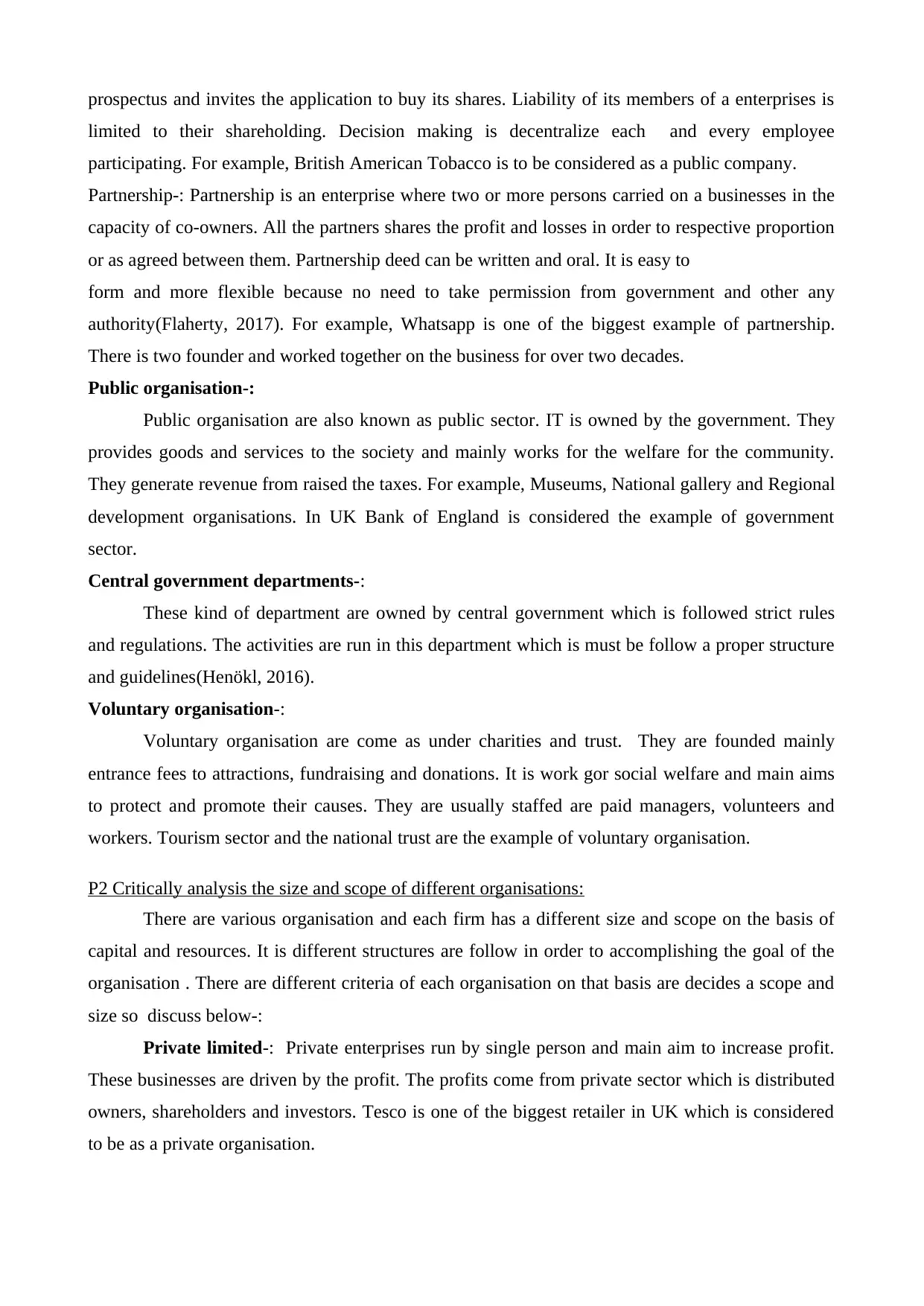
prospectus and invites the application to buy its shares. Liability of its members of a enterprises is
limited to their shareholding. Decision making is decentralize each and every employee
participating. For example, British American Tobacco is to be considered as a public company.
Partnership-: Partnership is an enterprise where two or more persons carried on a businesses in the
capacity of co-owners. All the partners shares the profit and losses in order to respective proportion
or as agreed between them. Partnership deed can be written and oral. It is easy to
form and more flexible because no need to take permission from government and other any
authority(Flaherty, 2017). For example, Whatsapp is one of the biggest example of partnership.
There is two founder and worked together on the business for over two decades.
Public organisation-:
Public organisation are also known as public sector. IT is owned by the government. They
provides goods and services to the society and mainly works for the welfare for the community.
They generate revenue from raised the taxes. For example, Museums, National gallery and Regional
development organisations. In UK Bank of England is considered the example of government
sector.
Central government departments-:
These kind of department are owned by central government which is followed strict rules
and regulations. The activities are run in this department which is must be follow a proper structure
and guidelines(Henökl, 2016).
Voluntary organisation-:
Voluntary organisation are come as under charities and trust. They are founded mainly
entrance fees to attractions, fundraising and donations. It is work gor social welfare and main aims
to protect and promote their causes. They are usually staffed are paid managers, volunteers and
workers. Tourism sector and the national trust are the example of voluntary organisation.
P2 Critically analysis the size and scope of different organisations:
There are various organisation and each firm has a different size and scope on the basis of
capital and resources. It is different structures are follow in order to accomplishing the goal of the
organisation . There are different criteria of each organisation on that basis are decides a scope and
size so discuss below-:
Private limited-: Private enterprises run by single person and main aim to increase profit.
These businesses are driven by the profit. The profits come from private sector which is distributed
owners, shareholders and investors. Tesco is one of the biggest retailer in UK which is considered
to be as a private organisation.
limited to their shareholding. Decision making is decentralize each and every employee
participating. For example, British American Tobacco is to be considered as a public company.
Partnership-: Partnership is an enterprise where two or more persons carried on a businesses in the
capacity of co-owners. All the partners shares the profit and losses in order to respective proportion
or as agreed between them. Partnership deed can be written and oral. It is easy to
form and more flexible because no need to take permission from government and other any
authority(Flaherty, 2017). For example, Whatsapp is one of the biggest example of partnership.
There is two founder and worked together on the business for over two decades.
Public organisation-:
Public organisation are also known as public sector. IT is owned by the government. They
provides goods and services to the society and mainly works for the welfare for the community.
They generate revenue from raised the taxes. For example, Museums, National gallery and Regional
development organisations. In UK Bank of England is considered the example of government
sector.
Central government departments-:
These kind of department are owned by central government which is followed strict rules
and regulations. The activities are run in this department which is must be follow a proper structure
and guidelines(Henökl, 2016).
Voluntary organisation-:
Voluntary organisation are come as under charities and trust. They are founded mainly
entrance fees to attractions, fundraising and donations. It is work gor social welfare and main aims
to protect and promote their causes. They are usually staffed are paid managers, volunteers and
workers. Tourism sector and the national trust are the example of voluntary organisation.
P2 Critically analysis the size and scope of different organisations:
There are various organisation and each firm has a different size and scope on the basis of
capital and resources. It is different structures are follow in order to accomplishing the goal of the
organisation . There are different criteria of each organisation on that basis are decides a scope and
size so discuss below-:
Private limited-: Private enterprises run by single person and main aim to increase profit.
These businesses are driven by the profit. The profits come from private sector which is distributed
owners, shareholders and investors. Tesco is one of the biggest retailer in UK which is considered
to be as a private organisation.
Paraphrase This Document
Need a fresh take? Get an instant paraphrase of this document with our AI Paraphraser
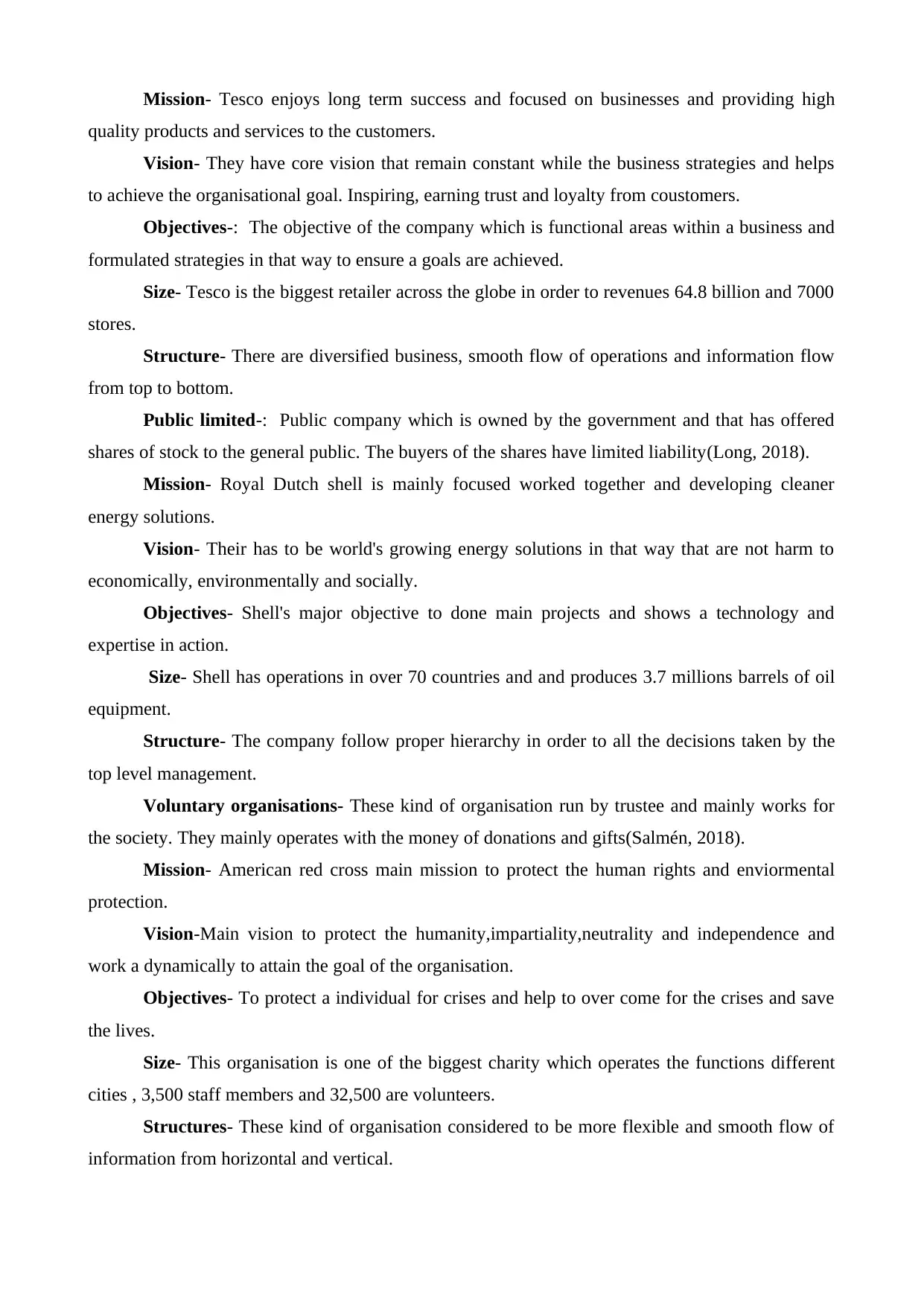
Mission- Tesco enjoys long term success and focused on businesses and providing high
quality products and services to the customers.
Vision- They have core vision that remain constant while the business strategies and helps
to achieve the organisational goal. Inspiring, earning trust and loyalty from coustomers.
Objectives-: The objective of the company which is functional areas within a business and
formulated strategies in that way to ensure a goals are achieved.
Size- Tesco is the biggest retailer across the globe in order to revenues 64.8 billion and 7000
stores.
Structure- There are diversified business, smooth flow of operations and information flow
from top to bottom.
Public limited-: Public company which is owned by the government and that has offered
shares of stock to the general public. The buyers of the shares have limited liability(Long, 2018).
Mission- Royal Dutch shell is mainly focused worked together and developing cleaner
energy solutions.
Vision- Their has to be world's growing energy solutions in that way that are not harm to
economically, environmentally and socially.
Objectives- Shell's major objective to done main projects and shows a technology and
expertise in action.
Size- Shell has operations in over 70 countries and and produces 3.7 millions barrels of oil
equipment.
Structure- The company follow proper hierarchy in order to all the decisions taken by the
top level management.
Voluntary organisations- These kind of organisation run by trustee and mainly works for
the society. They mainly operates with the money of donations and gifts(Salmén, 2018).
Mission- American red cross main mission to protect the human rights and enviormental
protection.
Vision-Main vision to protect the humanity,impartiality,neutrality and independence and
work a dynamically to attain the goal of the organisation.
Objectives- To protect a individual for crises and help to over come for the crises and save
the lives.
Size- This organisation is one of the biggest charity which operates the functions different
cities , 3,500 staff members and 32,500 are volunteers.
Structures- These kind of organisation considered to be more flexible and smooth flow of
information from horizontal and vertical.
quality products and services to the customers.
Vision- They have core vision that remain constant while the business strategies and helps
to achieve the organisational goal. Inspiring, earning trust and loyalty from coustomers.
Objectives-: The objective of the company which is functional areas within a business and
formulated strategies in that way to ensure a goals are achieved.
Size- Tesco is the biggest retailer across the globe in order to revenues 64.8 billion and 7000
stores.
Structure- There are diversified business, smooth flow of operations and information flow
from top to bottom.
Public limited-: Public company which is owned by the government and that has offered
shares of stock to the general public. The buyers of the shares have limited liability(Long, 2018).
Mission- Royal Dutch shell is mainly focused worked together and developing cleaner
energy solutions.
Vision- Their has to be world's growing energy solutions in that way that are not harm to
economically, environmentally and socially.
Objectives- Shell's major objective to done main projects and shows a technology and
expertise in action.
Size- Shell has operations in over 70 countries and and produces 3.7 millions barrels of oil
equipment.
Structure- The company follow proper hierarchy in order to all the decisions taken by the
top level management.
Voluntary organisations- These kind of organisation run by trustee and mainly works for
the society. They mainly operates with the money of donations and gifts(Salmén, 2018).
Mission- American red cross main mission to protect the human rights and enviormental
protection.
Vision-Main vision to protect the humanity,impartiality,neutrality and independence and
work a dynamically to attain the goal of the organisation.
Objectives- To protect a individual for crises and help to over come for the crises and save
the lives.
Size- This organisation is one of the biggest charity which operates the functions different
cities , 3,500 staff members and 32,500 are volunteers.
Structures- These kind of organisation considered to be more flexible and smooth flow of
information from horizontal and vertical.
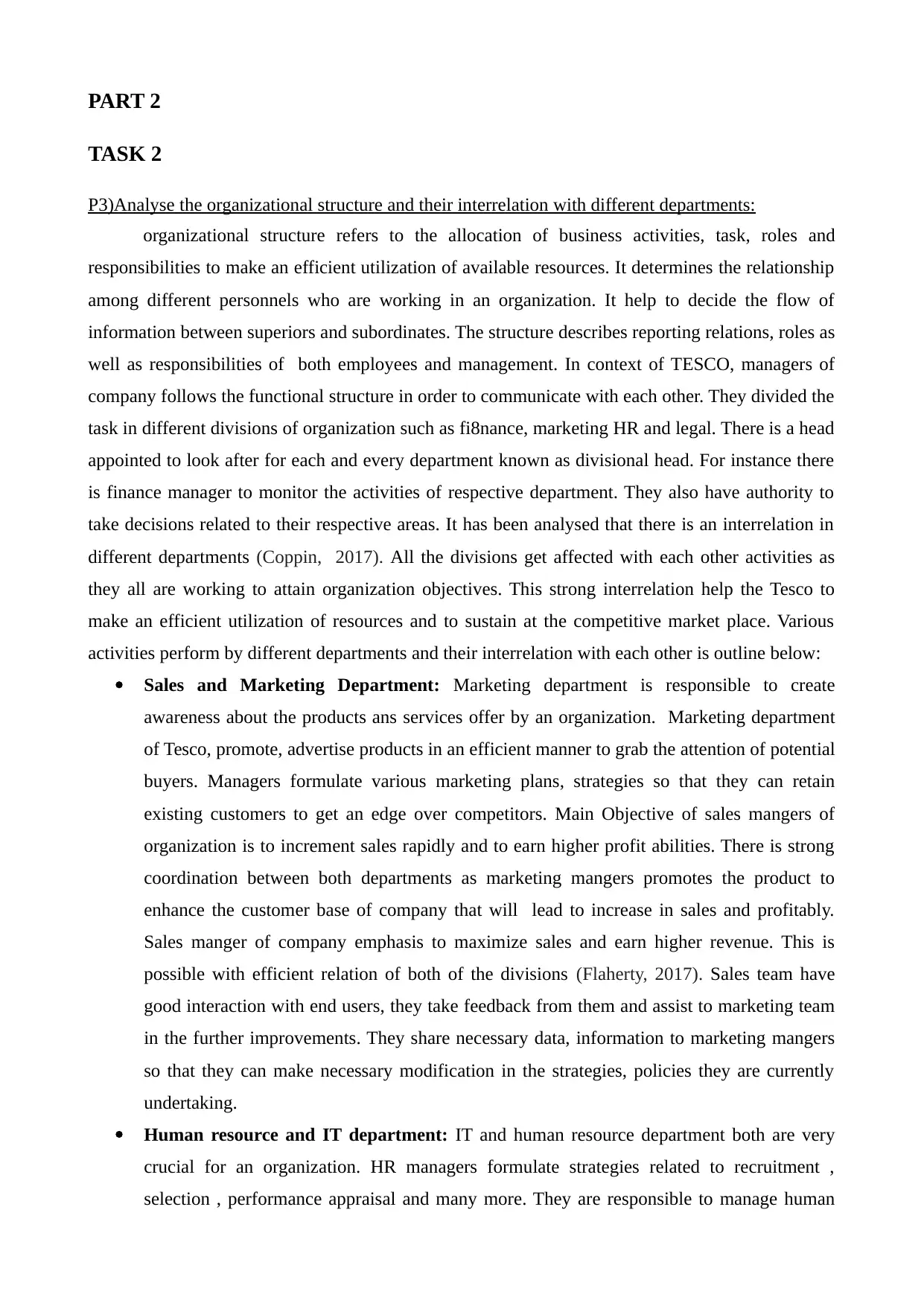
PART 2
TASK 2
P3)Analyse the organizational structure and their interrelation with different departments:
organizational structure refers to the allocation of business activities, task, roles and
responsibilities to make an efficient utilization of available resources. It determines the relationship
among different personnels who are working in an organization. It help to decide the flow of
information between superiors and subordinates. The structure describes reporting relations, roles as
well as responsibilities of both employees and management. In context of TESCO, managers of
company follows the functional structure in order to communicate with each other. They divided the
task in different divisions of organization such as fi8nance, marketing HR and legal. There is a head
appointed to look after for each and every department known as divisional head. For instance there
is finance manager to monitor the activities of respective department. They also have authority to
take decisions related to their respective areas. It has been analysed that there is an interrelation in
different departments (Coppin, 2017). All the divisions get affected with each other activities as
they all are working to attain organization objectives. This strong interrelation help the Tesco to
make an efficient utilization of resources and to sustain at the competitive market place. Various
activities perform by different departments and their interrelation with each other is outline below:
Sales and Marketing Department: Marketing department is responsible to create
awareness about the products ans services offer by an organization. Marketing department
of Tesco, promote, advertise products in an efficient manner to grab the attention of potential
buyers. Managers formulate various marketing plans, strategies so that they can retain
existing customers to get an edge over competitors. Main Objective of sales mangers of
organization is to increment sales rapidly and to earn higher profit abilities. There is strong
coordination between both departments as marketing mangers promotes the product to
enhance the customer base of company that will lead to increase in sales and profitably.
Sales manger of company emphasis to maximize sales and earn higher revenue. This is
possible with efficient relation of both of the divisions (Flaherty, 2017). Sales team have
good interaction with end users, they take feedback from them and assist to marketing team
in the further improvements. They share necessary data, information to marketing mangers
so that they can make necessary modification in the strategies, policies they are currently
undertaking.
Human resource and IT department: IT and human resource department both are very
crucial for an organization. HR managers formulate strategies related to recruitment ,
selection , performance appraisal and many more. They are responsible to manage human
TASK 2
P3)Analyse the organizational structure and their interrelation with different departments:
organizational structure refers to the allocation of business activities, task, roles and
responsibilities to make an efficient utilization of available resources. It determines the relationship
among different personnels who are working in an organization. It help to decide the flow of
information between superiors and subordinates. The structure describes reporting relations, roles as
well as responsibilities of both employees and management. In context of TESCO, managers of
company follows the functional structure in order to communicate with each other. They divided the
task in different divisions of organization such as fi8nance, marketing HR and legal. There is a head
appointed to look after for each and every department known as divisional head. For instance there
is finance manager to monitor the activities of respective department. They also have authority to
take decisions related to their respective areas. It has been analysed that there is an interrelation in
different departments (Coppin, 2017). All the divisions get affected with each other activities as
they all are working to attain organization objectives. This strong interrelation help the Tesco to
make an efficient utilization of resources and to sustain at the competitive market place. Various
activities perform by different departments and their interrelation with each other is outline below:
Sales and Marketing Department: Marketing department is responsible to create
awareness about the products ans services offer by an organization. Marketing department
of Tesco, promote, advertise products in an efficient manner to grab the attention of potential
buyers. Managers formulate various marketing plans, strategies so that they can retain
existing customers to get an edge over competitors. Main Objective of sales mangers of
organization is to increment sales rapidly and to earn higher profit abilities. There is strong
coordination between both departments as marketing mangers promotes the product to
enhance the customer base of company that will lead to increase in sales and profitably.
Sales manger of company emphasis to maximize sales and earn higher revenue. This is
possible with efficient relation of both of the divisions (Flaherty, 2017). Sales team have
good interaction with end users, they take feedback from them and assist to marketing team
in the further improvements. They share necessary data, information to marketing mangers
so that they can make necessary modification in the strategies, policies they are currently
undertaking.
Human resource and IT department: IT and human resource department both are very
crucial for an organization. HR managers formulate strategies related to recruitment ,
selection , performance appraisal and many more. They are responsible to manage human
⊘ This is a preview!⊘
Do you want full access?
Subscribe today to unlock all pages.

Trusted by 1+ million students worldwide
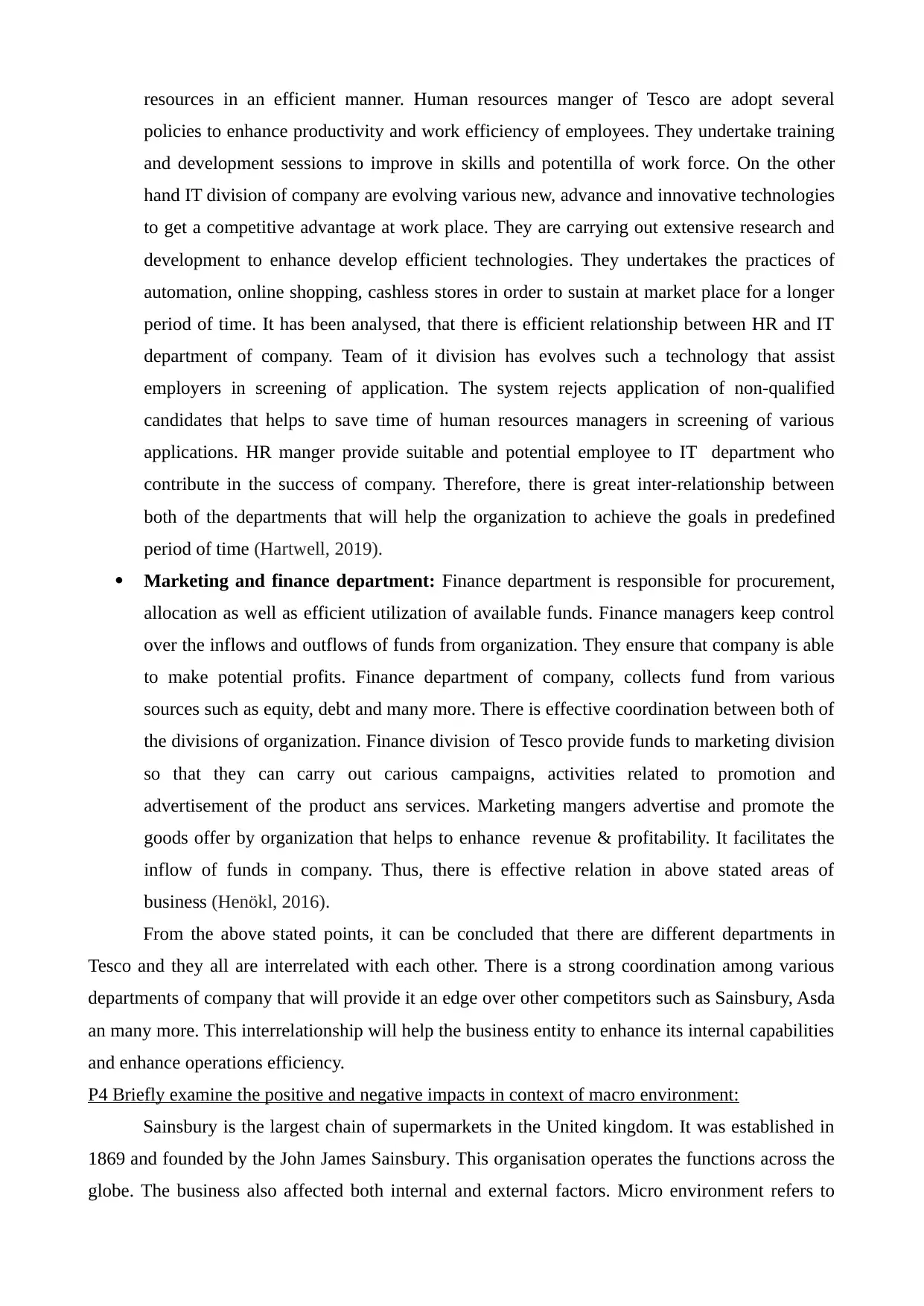
resources in an efficient manner. Human resources manger of Tesco are adopt several
policies to enhance productivity and work efficiency of employees. They undertake training
and development sessions to improve in skills and potentilla of work force. On the other
hand IT division of company are evolving various new, advance and innovative technologies
to get a competitive advantage at work place. They are carrying out extensive research and
development to enhance develop efficient technologies. They undertakes the practices of
automation, online shopping, cashless stores in order to sustain at market place for a longer
period of time. It has been analysed, that there is efficient relationship between HR and IT
department of company. Team of it division has evolves such a technology that assist
employers in screening of application. The system rejects application of non-qualified
candidates that helps to save time of human resources managers in screening of various
applications. HR manger provide suitable and potential employee to IT department who
contribute in the success of company. Therefore, there is great inter-relationship between
both of the departments that will help the organization to achieve the goals in predefined
period of time (Hartwell, 2019).
Marketing and finance department: Finance department is responsible for procurement,
allocation as well as efficient utilization of available funds. Finance managers keep control
over the inflows and outflows of funds from organization. They ensure that company is able
to make potential profits. Finance department of company, collects fund from various
sources such as equity, debt and many more. There is effective coordination between both of
the divisions of organization. Finance division of Tesco provide funds to marketing division
so that they can carry out carious campaigns, activities related to promotion and
advertisement of the product ans services. Marketing mangers advertise and promote the
goods offer by organization that helps to enhance revenue & profitability. It facilitates the
inflow of funds in company. Thus, there is effective relation in above stated areas of
business (Henökl, 2016).
From the above stated points, it can be concluded that there are different departments in
Tesco and they all are interrelated with each other. There is a strong coordination among various
departments of company that will provide it an edge over other competitors such as Sainsbury, Asda
an many more. This interrelationship will help the business entity to enhance its internal capabilities
and enhance operations efficiency.
P4 Briefly examine the positive and negative impacts in context of macro environment:
Sainsbury is the largest chain of supermarkets in the United kingdom. It was established in
1869 and founded by the John James Sainsbury. This organisation operates the functions across the
globe. The business also affected both internal and external factors. Micro environment refers to
policies to enhance productivity and work efficiency of employees. They undertake training
and development sessions to improve in skills and potentilla of work force. On the other
hand IT division of company are evolving various new, advance and innovative technologies
to get a competitive advantage at work place. They are carrying out extensive research and
development to enhance develop efficient technologies. They undertakes the practices of
automation, online shopping, cashless stores in order to sustain at market place for a longer
period of time. It has been analysed, that there is efficient relationship between HR and IT
department of company. Team of it division has evolves such a technology that assist
employers in screening of application. The system rejects application of non-qualified
candidates that helps to save time of human resources managers in screening of various
applications. HR manger provide suitable and potential employee to IT department who
contribute in the success of company. Therefore, there is great inter-relationship between
both of the departments that will help the organization to achieve the goals in predefined
period of time (Hartwell, 2019).
Marketing and finance department: Finance department is responsible for procurement,
allocation as well as efficient utilization of available funds. Finance managers keep control
over the inflows and outflows of funds from organization. They ensure that company is able
to make potential profits. Finance department of company, collects fund from various
sources such as equity, debt and many more. There is effective coordination between both of
the divisions of organization. Finance division of Tesco provide funds to marketing division
so that they can carry out carious campaigns, activities related to promotion and
advertisement of the product ans services. Marketing mangers advertise and promote the
goods offer by organization that helps to enhance revenue & profitability. It facilitates the
inflow of funds in company. Thus, there is effective relation in above stated areas of
business (Henökl, 2016).
From the above stated points, it can be concluded that there are different departments in
Tesco and they all are interrelated with each other. There is a strong coordination among various
departments of company that will provide it an edge over other competitors such as Sainsbury, Asda
an many more. This interrelationship will help the business entity to enhance its internal capabilities
and enhance operations efficiency.
P4 Briefly examine the positive and negative impacts in context of macro environment:
Sainsbury is the largest chain of supermarkets in the United kingdom. It was established in
1869 and founded by the John James Sainsbury. This organisation operates the functions across the
globe. The business also affected both internal and external factors. Micro environment refers to
Paraphrase This Document
Need a fresh take? Get an instant paraphrase of this document with our AI Paraphraser
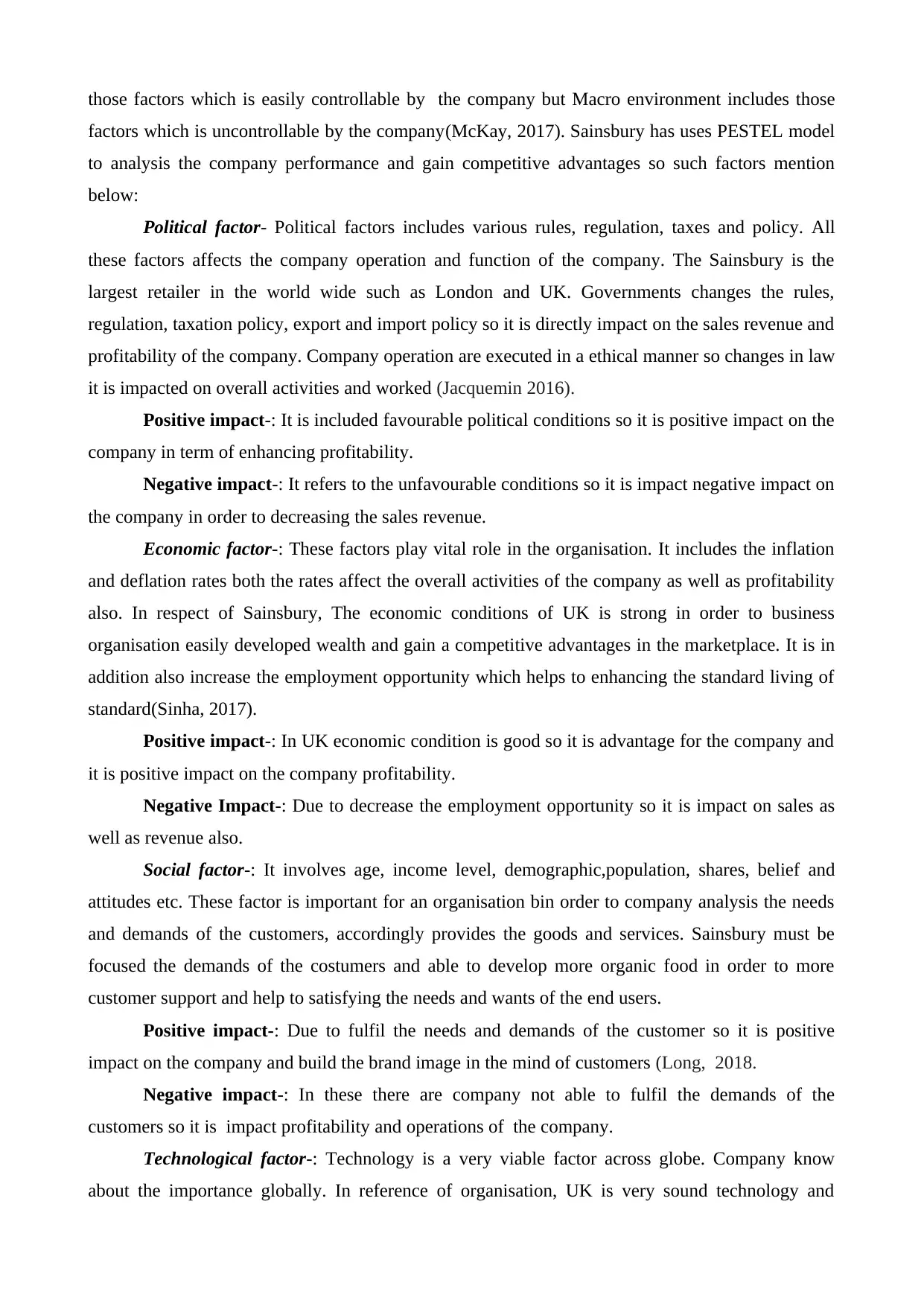
those factors which is easily controllable by the company but Macro environment includes those
factors which is uncontrollable by the company(McKay, 2017). Sainsbury has uses PESTEL model
to analysis the company performance and gain competitive advantages so such factors mention
below:
Political factor- Political factors includes various rules, regulation, taxes and policy. All
these factors affects the company operation and function of the company. The Sainsbury is the
largest retailer in the world wide such as London and UK. Governments changes the rules,
regulation, taxation policy, export and import policy so it is directly impact on the sales revenue and
profitability of the company. Company operation are executed in a ethical manner so changes in law
it is impacted on overall activities and worked (Jacquemin 2016).
Positive impact-: It is included favourable political conditions so it is positive impact on the
company in term of enhancing profitability.
Negative impact-: It refers to the unfavourable conditions so it is impact negative impact on
the company in order to decreasing the sales revenue.
Economic factor-: These factors play vital role in the organisation. It includes the inflation
and deflation rates both the rates affect the overall activities of the company as well as profitability
also. In respect of Sainsbury, The economic conditions of UK is strong in order to business
organisation easily developed wealth and gain a competitive advantages in the marketplace. It is in
addition also increase the employment opportunity which helps to enhancing the standard living of
standard(Sinha, 2017).
Positive impact-: In UK economic condition is good so it is advantage for the company and
it is positive impact on the company profitability.
Negative Impact-: Due to decrease the employment opportunity so it is impact on sales as
well as revenue also.
Social factor-: It involves age, income level, demographic,population, shares, belief and
attitudes etc. These factor is important for an organisation bin order to company analysis the needs
and demands of the customers, accordingly provides the goods and services. Sainsbury must be
focused the demands of the costumers and able to develop more organic food in order to more
customer support and help to satisfying the needs and wants of the end users.
Positive impact-: Due to fulfil the needs and demands of the customer so it is positive
impact on the company and build the brand image in the mind of customers (Long, 2018.
Negative impact-: In these there are company not able to fulfil the demands of the
customers so it is impact profitability and operations of the company.
Technological factor-: Technology is a very viable factor across globe. Company know
about the importance globally. In reference of organisation, UK is very sound technology and
factors which is uncontrollable by the company(McKay, 2017). Sainsbury has uses PESTEL model
to analysis the company performance and gain competitive advantages so such factors mention
below:
Political factor- Political factors includes various rules, regulation, taxes and policy. All
these factors affects the company operation and function of the company. The Sainsbury is the
largest retailer in the world wide such as London and UK. Governments changes the rules,
regulation, taxation policy, export and import policy so it is directly impact on the sales revenue and
profitability of the company. Company operation are executed in a ethical manner so changes in law
it is impacted on overall activities and worked (Jacquemin 2016).
Positive impact-: It is included favourable political conditions so it is positive impact on the
company in term of enhancing profitability.
Negative impact-: It refers to the unfavourable conditions so it is impact negative impact on
the company in order to decreasing the sales revenue.
Economic factor-: These factors play vital role in the organisation. It includes the inflation
and deflation rates both the rates affect the overall activities of the company as well as profitability
also. In respect of Sainsbury, The economic conditions of UK is strong in order to business
organisation easily developed wealth and gain a competitive advantages in the marketplace. It is in
addition also increase the employment opportunity which helps to enhancing the standard living of
standard(Sinha, 2017).
Positive impact-: In UK economic condition is good so it is advantage for the company and
it is positive impact on the company profitability.
Negative Impact-: Due to decrease the employment opportunity so it is impact on sales as
well as revenue also.
Social factor-: It involves age, income level, demographic,population, shares, belief and
attitudes etc. These factor is important for an organisation bin order to company analysis the needs
and demands of the customers, accordingly provides the goods and services. Sainsbury must be
focused the demands of the costumers and able to develop more organic food in order to more
customer support and help to satisfying the needs and wants of the end users.
Positive impact-: Due to fulfil the needs and demands of the customer so it is positive
impact on the company and build the brand image in the mind of customers (Long, 2018.
Negative impact-: In these there are company not able to fulfil the demands of the
customers so it is impact profitability and operations of the company.
Technological factor-: Technology is a very viable factor across globe. Company know
about the importance globally. In reference of organisation, UK is very sound technology and
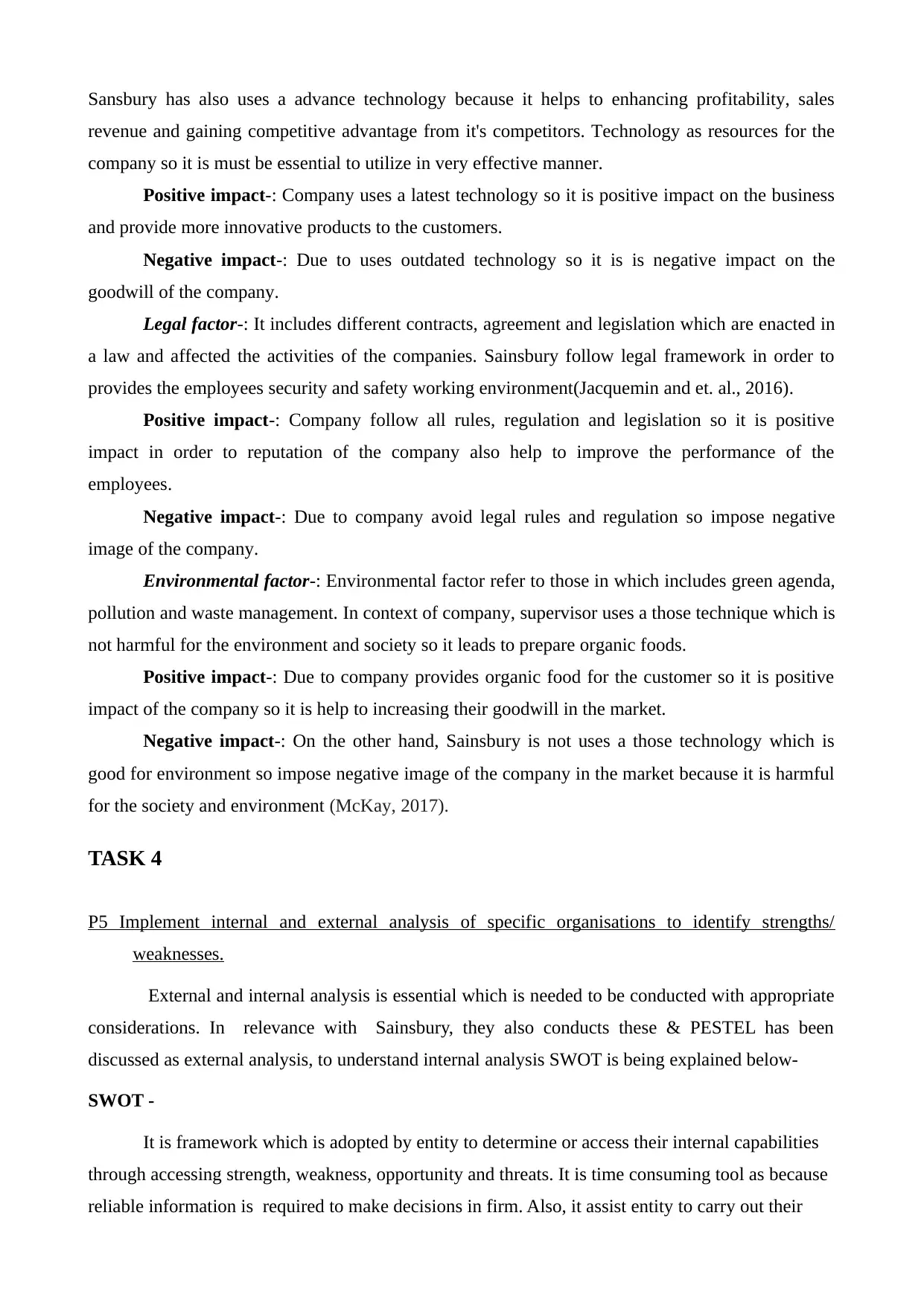
Sansbury has also uses a advance technology because it helps to enhancing profitability, sales
revenue and gaining competitive advantage from it's competitors. Technology as resources for the
company so it is must be essential to utilize in very effective manner.
Positive impact-: Company uses a latest technology so it is positive impact on the business
and provide more innovative products to the customers.
Negative impact-: Due to uses outdated technology so it is is negative impact on the
goodwill of the company.
Legal factor-: It includes different contracts, agreement and legislation which are enacted in
a law and affected the activities of the companies. Sainsbury follow legal framework in order to
provides the employees security and safety working environment(Jacquemin and et. al., 2016).
Positive impact-: Company follow all rules, regulation and legislation so it is positive
impact in order to reputation of the company also help to improve the performance of the
employees.
Negative impact-: Due to company avoid legal rules and regulation so impose negative
image of the company.
Environmental factor-: Environmental factor refer to those in which includes green agenda,
pollution and waste management. In context of company, supervisor uses a those technique which is
not harmful for the environment and society so it leads to prepare organic foods.
Positive impact-: Due to company provides organic food for the customer so it is positive
impact of the company so it is help to increasing their goodwill in the market.
Negative impact-: On the other hand, Sainsbury is not uses a those technology which is
good for environment so impose negative image of the company in the market because it is harmful
for the society and environment (McKay, 2017).
TASK 4
P5 Implement internal and external analysis of specific organisations to identify strengths/
weaknesses.
External and internal analysis is essential which is needed to be conducted with appropriate
considerations. In relevance with Sainsbury, they also conducts these & PESTEL has been
discussed as external analysis, to understand internal analysis SWOT is being explained below-
SWOT -
It is framework which is adopted by entity to determine or access their internal capabilities
through accessing strength, weakness, opportunity and threats. It is time consuming tool as because
reliable information is required to make decisions in firm. Also, it assist entity to carry out their
revenue and gaining competitive advantage from it's competitors. Technology as resources for the
company so it is must be essential to utilize in very effective manner.
Positive impact-: Company uses a latest technology so it is positive impact on the business
and provide more innovative products to the customers.
Negative impact-: Due to uses outdated technology so it is is negative impact on the
goodwill of the company.
Legal factor-: It includes different contracts, agreement and legislation which are enacted in
a law and affected the activities of the companies. Sainsbury follow legal framework in order to
provides the employees security and safety working environment(Jacquemin and et. al., 2016).
Positive impact-: Company follow all rules, regulation and legislation so it is positive
impact in order to reputation of the company also help to improve the performance of the
employees.
Negative impact-: Due to company avoid legal rules and regulation so impose negative
image of the company.
Environmental factor-: Environmental factor refer to those in which includes green agenda,
pollution and waste management. In context of company, supervisor uses a those technique which is
not harmful for the environment and society so it leads to prepare organic foods.
Positive impact-: Due to company provides organic food for the customer so it is positive
impact of the company so it is help to increasing their goodwill in the market.
Negative impact-: On the other hand, Sainsbury is not uses a those technology which is
good for environment so impose negative image of the company in the market because it is harmful
for the society and environment (McKay, 2017).
TASK 4
P5 Implement internal and external analysis of specific organisations to identify strengths/
weaknesses.
External and internal analysis is essential which is needed to be conducted with appropriate
considerations. In relevance with Sainsbury, they also conducts these & PESTEL has been
discussed as external analysis, to understand internal analysis SWOT is being explained below-
SWOT -
It is framework which is adopted by entity to determine or access their internal capabilities
through accessing strength, weakness, opportunity and threats. It is time consuming tool as because
reliable information is required to make decisions in firm. Also, it assist entity to carry out their
⊘ This is a preview!⊘
Do you want full access?
Subscribe today to unlock all pages.

Trusted by 1+ million students worldwide
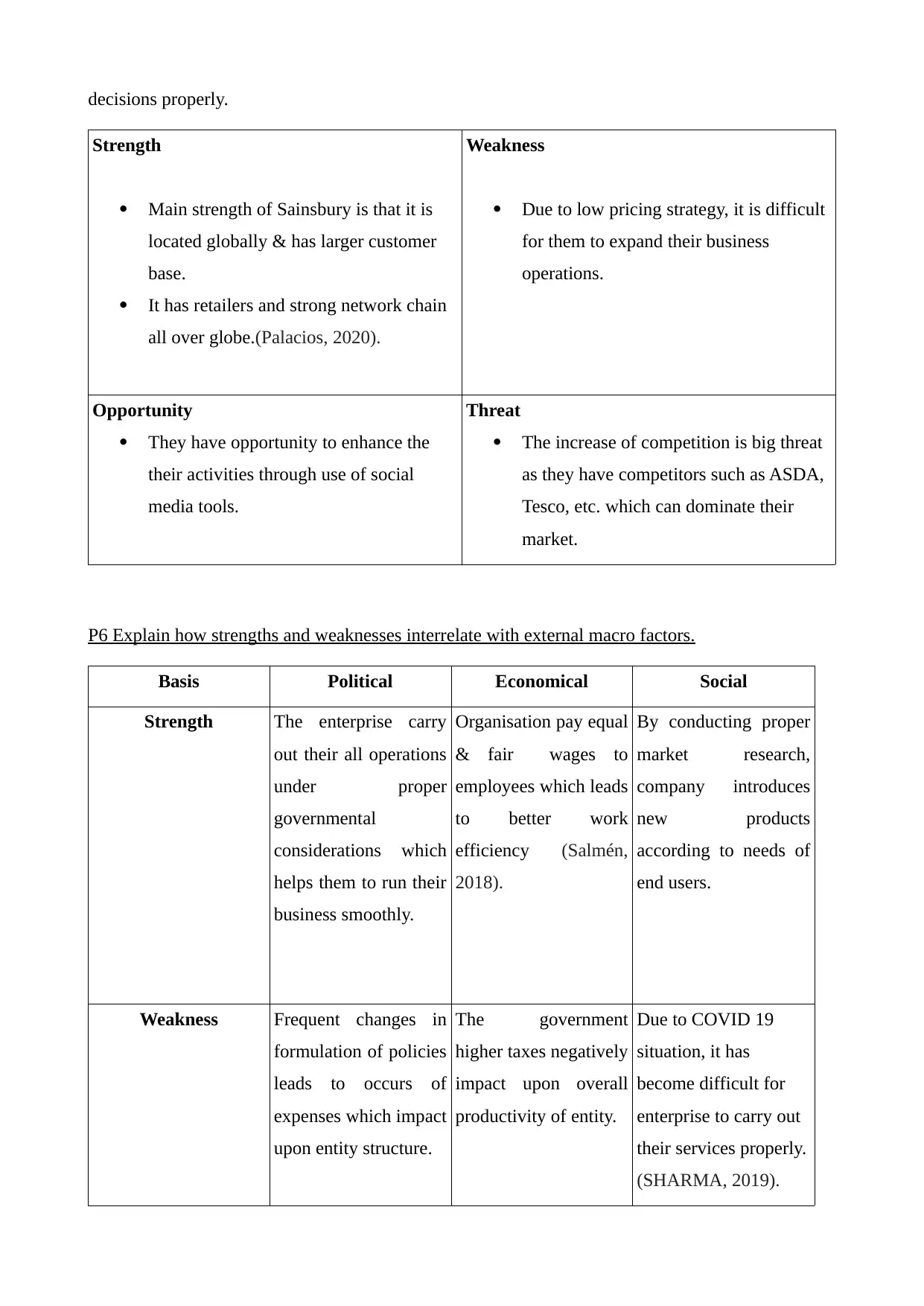
decisions properly.
Strength
Main strength of Sainsbury is that it is
located globally & has larger customer
base.
It has retailers and strong network chain
all over globe.(Palacios, 2020).
Weakness
Due to low pricing strategy, it is difficult
for them to expand their business
operations.
Opportunity
They have opportunity to enhance the
their activities through use of social
media tools.
Threat
The increase of competition is big threat
as they have competitors such as ASDA,
Tesco, etc. which can dominate their
market.
P6 Explain how strengths and weaknesses interrelate with external macro factors.
Basis Political Economical Social
Strength The enterprise carry
out their all operations
under proper
governmental
considerations which
helps them to run their
business smoothly.
Organisation pay equal
& fair wages to
employees which leads
to better work
efficiency (Salmén,
2018).
By conducting proper
market research,
company introduces
new products
according to needs of
end users.
Weakness Frequent changes in
formulation of policies
leads to occurs of
expenses which impact
upon entity structure.
The government
higher taxes negatively
impact upon overall
productivity of entity.
Due to COVID 19
situation, it has
become difficult for
enterprise to carry out
their services properly.
(SHARMA, 2019).
Strength
Main strength of Sainsbury is that it is
located globally & has larger customer
base.
It has retailers and strong network chain
all over globe.(Palacios, 2020).
Weakness
Due to low pricing strategy, it is difficult
for them to expand their business
operations.
Opportunity
They have opportunity to enhance the
their activities through use of social
media tools.
Threat
The increase of competition is big threat
as they have competitors such as ASDA,
Tesco, etc. which can dominate their
market.
P6 Explain how strengths and weaknesses interrelate with external macro factors.
Basis Political Economical Social
Strength The enterprise carry
out their all operations
under proper
governmental
considerations which
helps them to run their
business smoothly.
Organisation pay equal
& fair wages to
employees which leads
to better work
efficiency (Salmén,
2018).
By conducting proper
market research,
company introduces
new products
according to needs of
end users.
Weakness Frequent changes in
formulation of policies
leads to occurs of
expenses which impact
upon entity structure.
The government
higher taxes negatively
impact upon overall
productivity of entity.
Due to COVID 19
situation, it has
become difficult for
enterprise to carry out
their services properly.
(SHARMA, 2019).
Paraphrase This Document
Need a fresh take? Get an instant paraphrase of this document with our AI Paraphraser
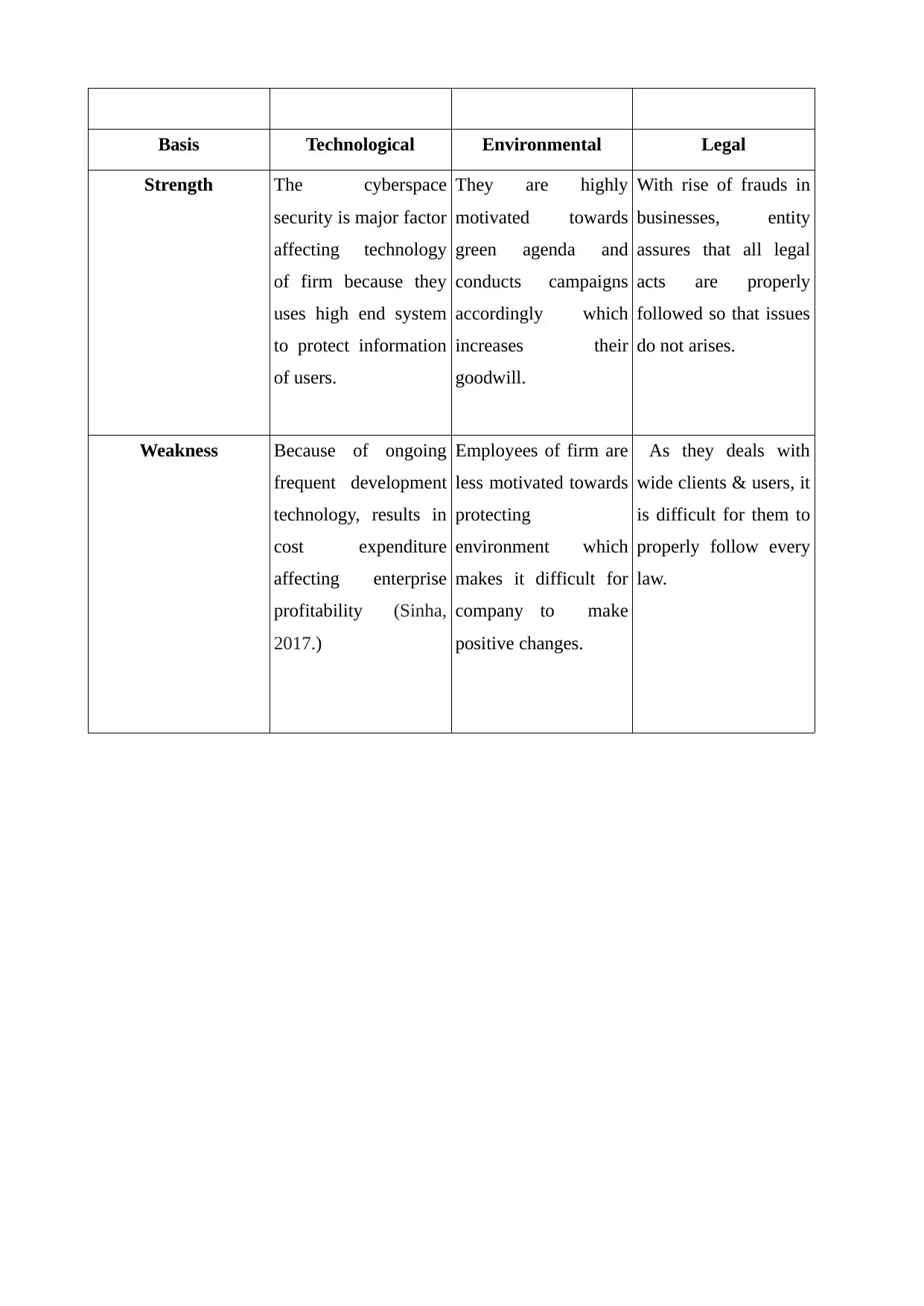
Basis Technological Environmental Legal
Strength The cyberspace
security is major factor
affecting technology
of firm because they
uses high end system
to protect information
of users.
They are highly
motivated towards
green agenda and
conducts campaigns
accordingly which
increases their
goodwill.
With rise of frauds in
businesses, entity
assures that all legal
acts are properly
followed so that issues
do not arises.
Weakness Because of ongoing
frequent development
technology, results in
cost expenditure
affecting enterprise
profitability (Sinha,
2017.)
Employees of firm are
less motivated towards
protecting
environment which
makes it difficult for
company to make
positive changes.
As they deals with
wide clients & users, it
is difficult for them to
properly follow every
law.
Strength The cyberspace
security is major factor
affecting technology
of firm because they
uses high end system
to protect information
of users.
They are highly
motivated towards
green agenda and
conducts campaigns
accordingly which
increases their
goodwill.
With rise of frauds in
businesses, entity
assures that all legal
acts are properly
followed so that issues
do not arises.
Weakness Because of ongoing
frequent development
technology, results in
cost expenditure
affecting enterprise
profitability (Sinha,
2017.)
Employees of firm are
less motivated towards
protecting
environment which
makes it difficult for
company to make
positive changes.
As they deals with
wide clients & users, it
is difficult for them to
properly follow every
law.
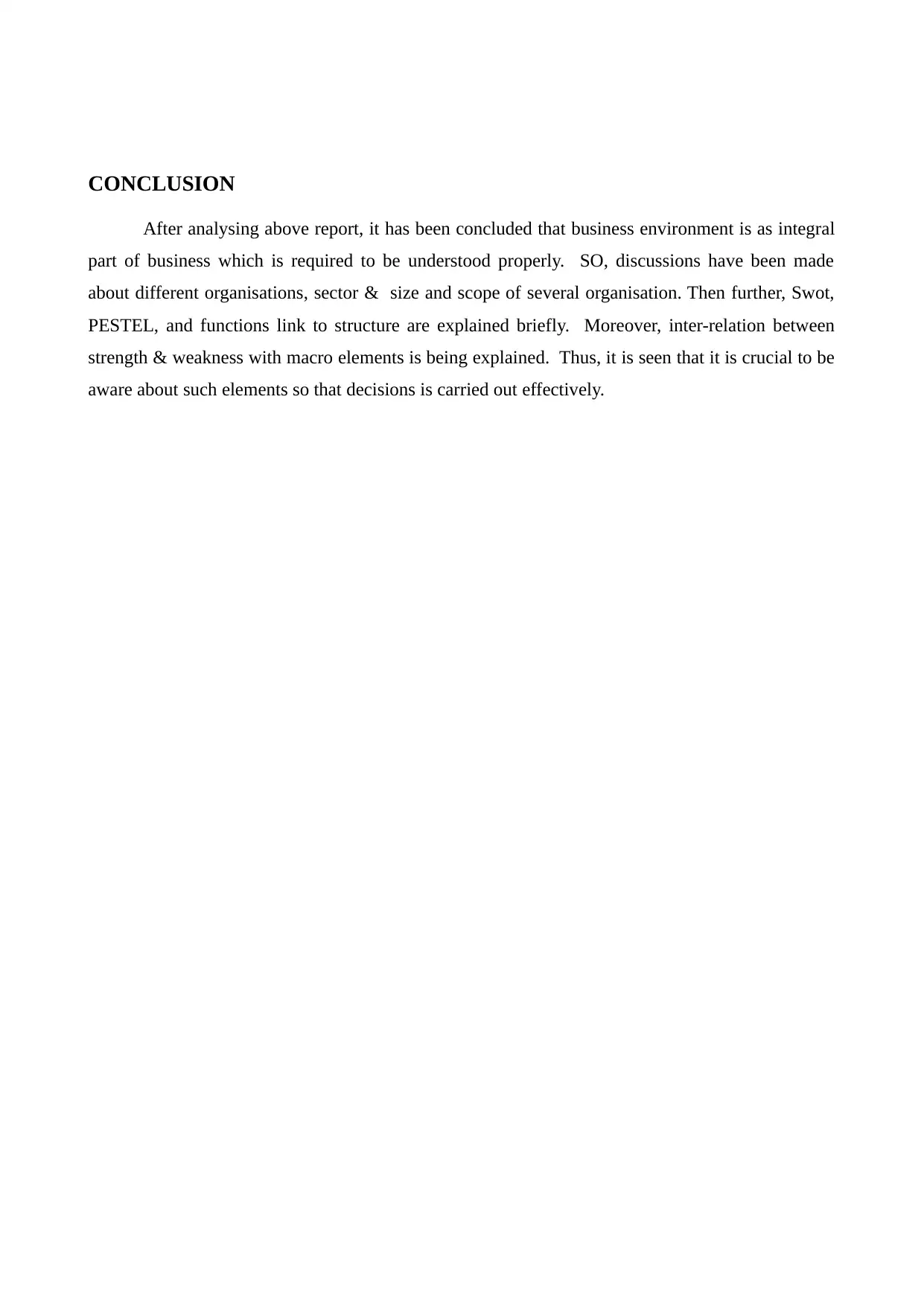
CONCLUSION
After analysing above report, it has been concluded that business environment is as integral
part of business which is required to be understood properly. SO, discussions have been made
about different organisations, sector & size and scope of several organisation. Then further, Swot,
PESTEL, and functions link to structure are explained briefly. Moreover, inter-relation between
strength & weakness with macro elements is being explained. Thus, it is seen that it is crucial to be
aware about such elements so that decisions is carried out effectively.
After analysing above report, it has been concluded that business environment is as integral
part of business which is required to be understood properly. SO, discussions have been made
about different organisations, sector & size and scope of several organisation. Then further, Swot,
PESTEL, and functions link to structure are explained briefly. Moreover, inter-relation between
strength & weakness with macro elements is being explained. Thus, it is seen that it is crucial to be
aware about such elements so that decisions is carried out effectively.
⊘ This is a preview!⊘
Do you want full access?
Subscribe today to unlock all pages.

Trusted by 1+ million students worldwide
1 out of 13
Related Documents
Your All-in-One AI-Powered Toolkit for Academic Success.
+13062052269
info@desklib.com
Available 24*7 on WhatsApp / Email
![[object Object]](/_next/static/media/star-bottom.7253800d.svg)
Unlock your academic potential
Copyright © 2020–2025 A2Z Services. All Rights Reserved. Developed and managed by ZUCOL.




